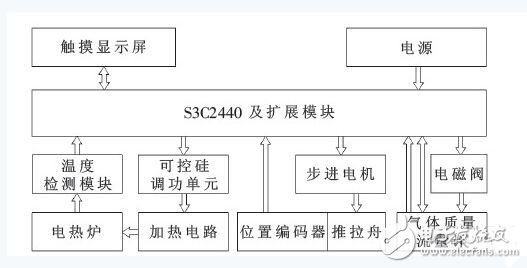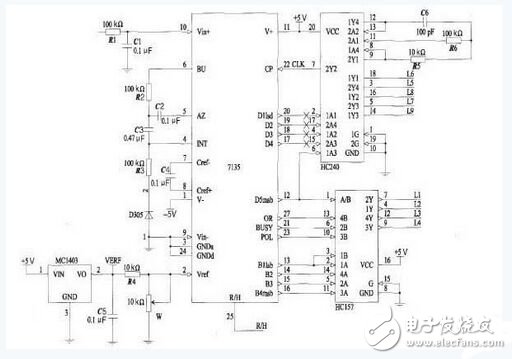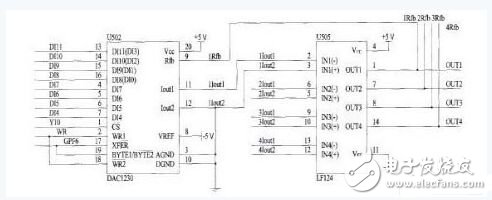With the development of information technology, intelligence and networking, embedded systems have achieved unprecedented development. Due to its small size, high performance and high reliability, embedded systems are widely used in industrial control, control instrumentation, communication and other fields. The diffusion/oxidation control system is a control system designed for diffusion oxidation furnaces. Diffusion/oxidation furnaces are one of the important process equipment for integrated circuit manufacturing. The system is mainly composed of high-precision temperature control system, push-pull boat control system and pneumatic circuit control system. This system provides a high-precision diffusion oxidation environment for the diffusion/oxidation furnace to produce high quality semiconductor products.
This article uses the ARM processor S3C2440, which has the characteristics of high operating frequency and rich on-chip resources, which can be well applied to the system. And the embedded WinCE is transplanted in the system design, which makes the control system have the characteristics of strong real-time, convenient programming and strong scalability.
1 Overall design of the diffusion/oxidation control system
As shown in Figure 1, the CPU and expansion modules of the system are based on the S3C2440 development board. There are temperature control subsystem, push-pull boat control subsystem and gas path control subsystem in the system. The above three subsystems are closed-loop systems, which complete the detection and control of temperature, stepper motor and gas mass flowmeter. The touch screen is used as a human machine interface to control and monitor the operation of the system.

Figure 1 System block diagram
2 control system hardware design
2.1 ARM microprocessor S3C2440
This design uses the Samsung S3C2440 processor. Its main frequency is 400 MHz, the external memory NAND Flash is 128 MB, and the SDRAM is 64 MB, which fully meets the requirements of the control system operation. The processor's on-chip resources include an LCD controller (supporting TFT LCD screen with touch screen), SDRAM controller, 117-bit general-purpose I/O port, and 24-bit external interrupt source. The system touch screen is 3.5 inches, resolution 240 & TImes; 320, to meet system requirements.
2.2 Temperature Control Subsystem Hardware Design
The temperature control subsystem requires four channels of temperature acquisition, one of which measures the ambient temperature and the other three measures the temperature of the diffusion/oxidation furnace. The system requires a temperature measurement range of 0 to 1 700 ° C and a full-scale resolution of 0.1 ° C.
To meet system requirements, thermocouples can be used for sensors that measure the diffusion/oxidation furnace. In order to meet the requirements of system measurement accuracy, and the speed requirement of the system A/D conversion is not very fast, the double integral type A/D converter ILC7135 is adopted. ILC7135 has high precision, good anti-interference performance, low price and wide application. The ICL7135 has a conversion range of -19 999 to +19 999, which means the resolution is 1/40 000. In order to increase the measurement accuracy, it is necessary to filter the signal input by the thermocouple. Because the system is mainly interfered by the power frequency signal, the filtering process mainly filters out the power frequency signal. When the signal is amplified, high-precision amplifiers such as OP07 and OP27 can be selected according to the requirements of the system. Figure 2 is a schematic diagram of the A/D conversion of the ILC7135. Because the S3C2440's pin is 3.3 V high, this circuit can be connected to the CPU using the level shifting chip SN74ALVCl64245 or 74LVC4254.
In this system, the thyristor-controlled resistance wire is used to warm the diffusion/oxidation furnace. In order to prevent the influence of the commercial power on the system, the photoelectric isolators must be used to isolate the connection between the system and the mains.

Figure 2 ILC7135 A / D conversion schematic
2.3 Hardware design of pneumatic system and push-pull system
In the diffusion/oxidation process, four different types and qualities of gas are required depending on the process. Therefore, in the pneumatic control system, four channels of switching are required to control the switching of four different gases, and four analog quantity control gas mass flow meters. The mass flow meter can output gas quality signals of 4 mA to 20 mA or 0 to 5 V. In systems with low control accuracy requirements, the gas quality signal output by the mass flow meter can be ignored. To ensure control accuracy, gas can be collected. Quality signal.
In the 4-way switch control, the relay can be used to control the on/off.
In a 4-channel analog-controlled gas mass flow meter, four D/A conversions are required. According to the requirements of control accuracy, the 12-bit D/A chip DAC1230 is selected. Because the control signal is a voltage signal, it is necessary to convert the current signal into a voltage signal. Figure 3 is a schematic diagram of the D/A conversion of the pneumatic circuit control system.

Figure 3 Schematic diagram of D/A conversion of pneumatic circuit control system
In the 4-way gas mass flow measurement, since the gas mass flow meter can output signals of 4 mA to 20 mA or 0 to 5 V, the A/D conversion chip is required to convert the two signals. According to the requirements of control accuracy, the 12-bit A/D conversion chip AD574 can be selected.
In the diffusion/oxidation process, the push-pull boat is used to transport the semiconductor chip and is driven by a stepper motor. The microprocessor S3C2440 has 4 PWM outputs, which can output pulses to the driver of the stepper motor to control the motion of the stepper motor. At the same time, the general I/O port is required to control the forward and reverse of the stepping motor.
In order to accurately obtain the current position of the push-pull boat, a position encoder is used to record the moving distance of the push-pull boat. In order to obtain the pulse of the position encoder, the number of pulses is recorded using 8254. The CPU scans the data of the 8254 and calculates the current position of the push-pull boat.
LiFePO4 Car Battery 12V
Lithium iron battery is more suitable for start & stop system vehicle than AGM battery
Lithium iron battery charge and discharge efficiency is two time higher than AGM battery, under the circumstance of start & stop system frequently starting working, lithium iron battery fast charge and discharge characteristics can make the start & stop system more stable in working efficiency and longer in battery life.
More suitable for car audio tuning than any other car
lithium iron battery is 0.8V higher in voltage than the lead-acid battery or winding battery , and the fast charge and discharge characteristics, the working voltage stabilized at roughly 14.4V, perfect to upgrade the car audio sound quality effect.
LiFePO4 Powersports Battery, lightweight motorcycle battery, lithium motorcycle battery
Starlight Power Industrial Company Limited , https://www.starlite-power.com